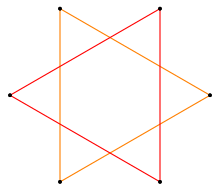
Hexagram
Six-pointed star polygon / From Wikipedia, the free encyclopedia
Dear Wikiwand AI, let's keep it short by simply answering these key questions:
Can you list the top facts and stats about Hexagram?
Summarize this article for a 10 year old
A hexagram (Greek) or sexagram (Latin) is a six-pointed geometric star figure with the Schläfli symbol {6/2}, 2{3}, or {{3}}. Since there are no true regular continuous hexagrams, the term is instead used to refer to a compound figure of two equilateral triangles. The intersection is a regular hexagon.
This article needs additional citations for verification. (March 2023) |
| Regular hexagram | |
|---|---|
 A regular hexagram | |
| Type | Regular polygonal figure |
| Edges and vertices | 6 |
| Schläfli symbol | a{6}, {6/2}, 2{3} or {{3}} |
| Coxeter–Dynkin diagrams | |
| Symmetry group | Dihedral (D6) |
| Internal angle (degrees) | 60° |
| Properties | star, compound, cyclic, equilateral, isogonal, isotoxal |
| Dual polygon | self |

The hexagram is part of an infinite series of shapes which are compounds of two n-dimensional simplices. In three dimensions, the analogous compound is the stellated octahedron, and in four dimensions the compound of two 5-cells is obtained.
It has been historically used in various religious and cultural contexts and as decorative motifs. The symbol was used as a decorative motif in medieval Christian churches and Jewish synagogues.[1] The hexagram is thought to have originated in Buddhism and was also used by Hindus. It was used by Muslims as a mystic symbol in the medieval period, known as the Seal of Solomon, depicted as either a hexagram or pentagram. [2][3]